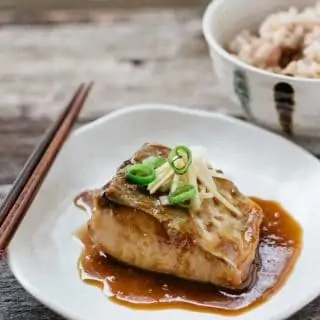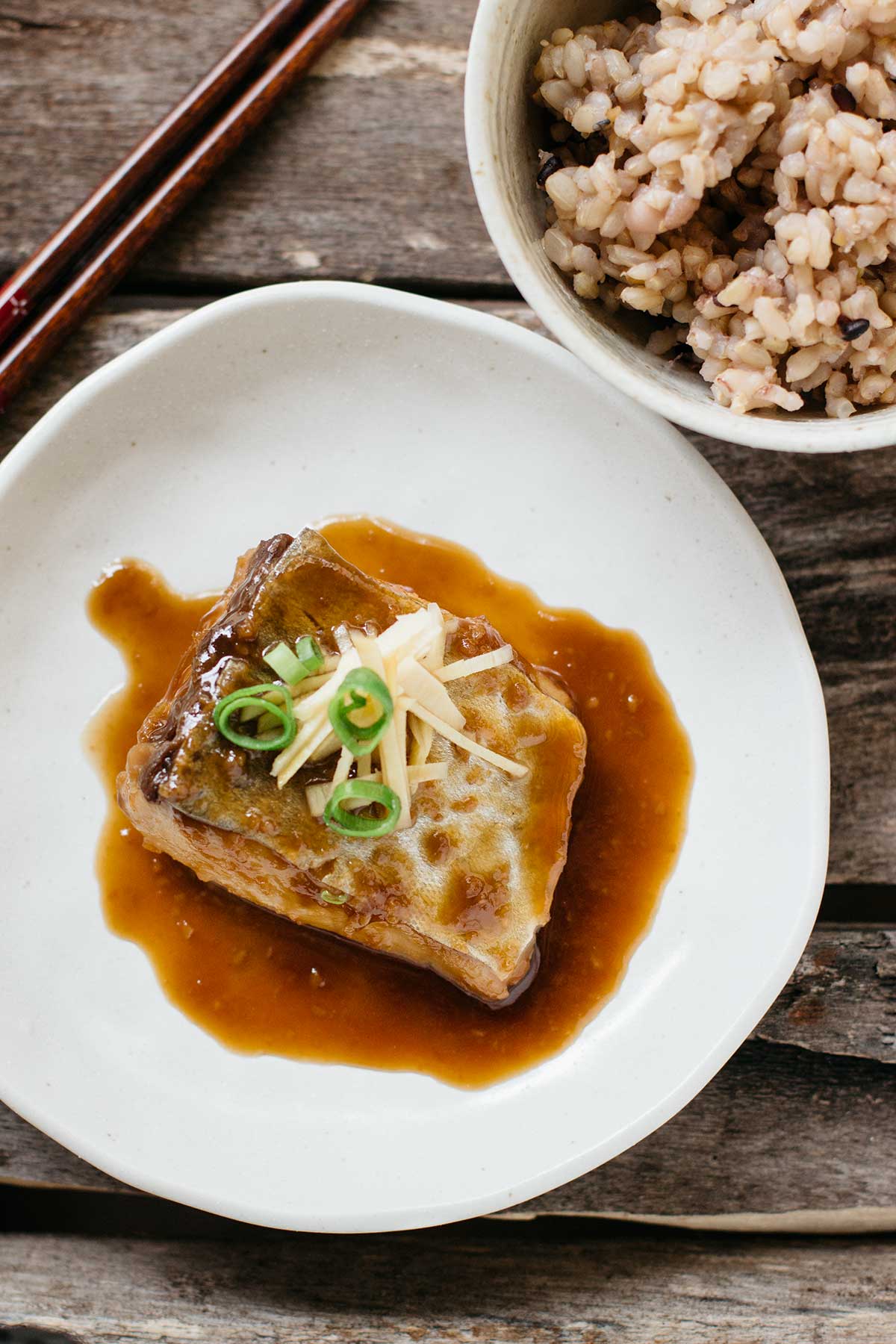Saba Misoni is a typical and traditional Japanese fish dish that Japanese people eat really often. Saba is Mackerel in English and Misoni, which is the way the fish is cooked in a miso sauce, is Japanese peoples’ favourite way to eat this fish.
Mackerel is also one of the oily types of fish that has a lot of health benefits, just like salmon. Eating this Saba Misoni can aid in protecting you against cardiovascular disease and dementia and it contains a lot of omega-3 fatty acids which are also good for your health. So this is a healthy, and simple, dish that makes a great weeknight dinner meal when you need something quick and easy to make so you don’t have to resort to junk food.
My father was a fisherman and I am from a small fishing town in Japan so we had plenty of fresh sea food everyday. We often had saba, so usually Saba Misoni was on our dinner table. My dad especially loves this dish so he eats it very often, he eats nearly every part of the fish, even the eyeballs (which doesn’t sound appetising, but is actually quite tasty). The fish also has blue coloured skin, which usually has a very fishy smelly even after it’s been cooked.
However, using ginger and miso to cook the fish can take off that fishy smell. This makes it a great fish dish because I hate when I cook fish and the whole house smells so fishy, especially when I cook salmon. You can eat this fish topped with some thinly sliced ginger and shallots with a side of rice to make a delicious, healthy, and traditional Japanese dish! I hope you enjoy it!

Saba Misoni
Ingredients
- 250 g Mackerel fillet
- 1 1/2 tbs miso paste
- 1 1/2 tbs sugar
- 1 1/2 tbs mirin
- 1/2 tbs soy sauce
- 1/3 cup water
- 1/4 cup sake
- 10 g ginger
- ginger and spring onion to garnish
Instructions
- Pour boiling water over the mackerel fillet and slice the ginger very thinly and set both aside.
- Put all the sauce ingredients into a shallow sauce pan or a frying pan over medium heat and bring to boil.
- Turn the heat down to low and add the mackerel.
- Put the lid on and simmer for about 10 minutes to reduce the sauce but be careful not to burn it.
- While simmering the fish, occasionally spoon the sauce over the fish.
- Garnish with ginger and spring onion to serve.



I made this a few days ago! But using a different kind of fish instead of mackerel. That miso sauce was soooo good and it took all of me to literally not lick my plate. Instead, I mixed whatever sauce was left and mixed it with rice.
Thank you for making misoni Peter 😀
Hi Shihoko san!
I still haven’t prepared the recipe but was wondering if the skin should be on top when simmering.
Love your recipes. Have tried several so far. Many thanks.
Hi Jeff, it doesn’t matter which side the skin should be 😀
Hi,
Do I discard boiling water I put mackerel in in the first step? Or add it to the sauce?
Is ginger for garnishing only? Or it goes in the sauce as well?
Thank you
Hi Di, yes discard the boiling water.You can use ginger for both garnishing and sauce as well if you like.
Shihoko-san, thank you so much for sharing this recipe! It was really delicious and there was no fishy smell at all (which is very good when you’re staying in a small unit without any kitchen exhaust).
I’ve been searching for this taste since I first tried it in Tokyo(Hotel Listel) about 10 years ago during a student exchange program, but couldn’t really find the right combination… Now I can finally eat it again! Thank you!
Hi Rin san. You are welcome. I am glad to know that now you can have authentic Saba Misoni in your country 😀
I was a bit confused by the ginger in the recipe list whereas the spring onions are not in the list. The ginger is only for garnish or also in the sauce? I overly reduced the sauce a bit by accident which made it really intense, but the recipe is lovely!
Hi Gijs van Wiechen, Thank you for making this and your feedback. I will update the recipe very soon. Thank you!
It’s hard to find mackerel in Australia. I live in NSW and I almost never see it. I’m from East Asia and I use to eat fried mackerel almost every week but now it’s difficult to come by so I make it with salmon instead.
Hi Jen I found same, it is difficult find the fish that I used to eat and find easily in Japan. If you try local markets or fish markets, they may have in season.
This is really delicious good work!
Oh thank you very much 🙂